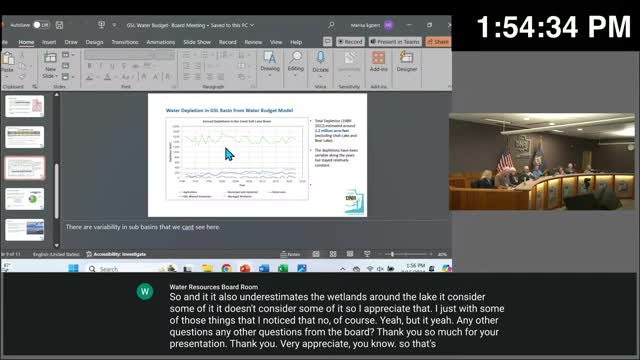State engineers outline urgent dam safety action plan
August 16, 2024 | Utah Office of Tourism, Utah Governor's Office of Economic Opportunity, Offices, Departments, and Divisions, Organizations, Utah Executive Branch, Utah

This article was created by AI summarizing key points discussed. AI makes mistakes, so for full details and context, please refer to the video of the full meeting. Please report any errors so we can fix them. Report an error »

In a recent government meeting, officials from the Division of Water Rights provided an extensive overview of the state's dam safety program, emphasizing its critical role in protecting public safety and property. State Engineer Teresa Wilhelmsen and Assistant State Engineer Everett Taylor outlined the division's responsibilities, which include the regulation of dam construction, inspection, and rehabilitation.
Wilhelmsen highlighted the historical context of dam safety regulations, tracing back to significant failures in the U.S. that prompted legislative action. The current framework, established after the Quail Creek dam failure in 1989, empowers the state engineer to oversee dam safety across Utah. This includes reviewing construction plans, conducting routine inspections, and ensuring compliance with safety standards.
Taylor detailed the four key areas of focus within the dam safety program: design approval, construction inspections, annual evaluations of existing dams, and rehabilitation efforts for high-hazard dams. He noted that the state inspects over 300 dams annually, providing reports to owners on necessary maintenance and updates to emergency action plans.
A significant point of discussion was the funding for dam rehabilitation. The state has a grant program to assist with the costs of upgrading high-hazard dams, with 17 dams currently undergoing rehabilitation. Taylor mentioned that the state has also applied for federal funding through FEMA, securing $7.2 million to support these efforts.
Board members raised concerns about the financial resources available for dam safety initiatives, emphasizing the need for ongoing engagement with policymakers to secure necessary funding. The discussion underscored the importance of maintaining and upgrading dam infrastructure to prevent potential failures that could threaten lives and property.
Overall, the meeting reinforced the commitment of the Division of Water Rights to ensure the safety and reliability of Utah's dams, while also highlighting the challenges posed by funding limitations and the need for collaborative efforts to address these issues effectively.
Wilhelmsen highlighted the historical context of dam safety regulations, tracing back to significant failures in the U.S. that prompted legislative action. The current framework, established after the Quail Creek dam failure in 1989, empowers the state engineer to oversee dam safety across Utah. This includes reviewing construction plans, conducting routine inspections, and ensuring compliance with safety standards.
Taylor detailed the four key areas of focus within the dam safety program: design approval, construction inspections, annual evaluations of existing dams, and rehabilitation efforts for high-hazard dams. He noted that the state inspects over 300 dams annually, providing reports to owners on necessary maintenance and updates to emergency action plans.
A significant point of discussion was the funding for dam rehabilitation. The state has a grant program to assist with the costs of upgrading high-hazard dams, with 17 dams currently undergoing rehabilitation. Taylor mentioned that the state has also applied for federal funding through FEMA, securing $7.2 million to support these efforts.
Board members raised concerns about the financial resources available for dam safety initiatives, emphasizing the need for ongoing engagement with policymakers to secure necessary funding. The discussion underscored the importance of maintaining and upgrading dam infrastructure to prevent potential failures that could threaten lives and property.
Overall, the meeting reinforced the commitment of the Division of Water Rights to ensure the safety and reliability of Utah's dams, while also highlighting the challenges posed by funding limitations and the need for collaborative efforts to address these issues effectively.
View full meeting
This article is based on a recent meeting—watch the full video and explore the complete transcript for deeper insights into the discussion.
View full meeting

